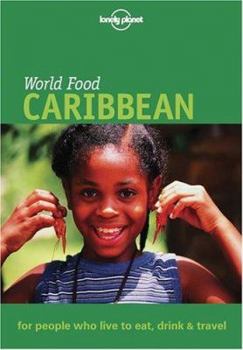Lonely Planet World Food: Caribbean
(Part of the Lonely Planet World Food Series)
Select Format
Select Condition 
Book Overview
This study uncovers local cuisine, home cooking and traditions using photography, recipes, cocktails and heady flavours for the traveller, chef and dreamer to enjoy. This description may be from another edition of this product.
Format:Paperback
Language:English
ISBN:1864503483
ISBN13:9781864503487
Release Date:January 2001
Publisher:Lonely Planet
Length:274 Pages
Weight:0.70 lbs.
Dimensions:0.6" x 4.5" x 6.5"
Customer Reviews
1 rating
Cultural Stew = A Caribbean Marketbasket
Published by Thriftbooks.com User , 22 years ago
11/4/2002 World Food Caribbean, "For people who live to eat, drink & travel" by Bruce Geodes This compact guide features a colorful history of the region, even etiquette, and each food group is addressed under: Staples & Specialties and includes Drinks,Home Cooking & Traditions, Food festivals Caribbean region culturesShopping and MarketsWhere to Eat and DrinkCaribbean Banquets Caribbean Culinary Dictionary. Although the Caribbean region, the West Indies, is one group of islands, their remoteness has caused each island to reflect the ways of whoever conquered them in the past. The major conquerors were the English, the Spanish, the Dutch and the French. Each island's blend also represented the ethnic background of imported laborers to work their back-breaking sugar fields. These workers came from India, Asia and Africa and each brought their eating habits and usually some seeds for the future. Additionally, the Amerindians, or original inhabitants, had simple fare which mixed in with the ways of conquering cultures and in-coming laborers. This three-way juncture created foods and ways available no other way. The book contains some recipes. Fruits, often beautiful and exotic, grow abundantly on the islands, and the book goes into some detail about many of them. A rum factory is usually found on many islands, for it is an important byproduct of sugar, so is the manufacture of a local beer. The many fruits lend to signature Rum Punches. Fruit shows up frequently in main dish recipes, as well. In a land of islands, it stands to reason fish and seafood figure highly in the Caribbean region diet. Herbs and spices grow abundantly too which causes the people to depend upon them for medicinal reasons and bush teas in addition to seasoning food. West Indies grown nutmeg, mace, ginger and garlic add to the flair of local cuisines. Chile peppers, coconut and island-grown spices dress up local foods, while basic beans, rice and tubers balance a rich diet. Look up festivals and carnivals which are big in the islands, some named "Crop Over," celebrating the completion of the sugar harvest. Others are cook-offs and those associated with the Lenten season. A quick catch-up is the book's green inserts entitled, "Don't Miss," which line out sights as well as foods to try. Some random samplings: Dutch: Curacao, Aruba, Bonnaire and Sint Maarten - Dutch cheeses, iguana soup, Indonesian and Papiamento cuisines. French:Guadeloupe, Martinique and Haiti, French-influenced with wines from France, spicy Creole fish dishes, fresh baked goods. Hatian music is especially lilting. English:Jamaica, ackee & salt fish, jerk pork with recipeBarbados, its coo-coo and flying fishTrinidad, roti, hot curries, callalloo soup, cou-cou (cuscous),Nassau, conch Spanish:Cuba, pizza, jamon (ham) chorizo sausage and onionPuerto Rico, sofrito The Food Directory is broken down into upscale, pubs and mid-range, fast food/cheap eateries, street food and ba





